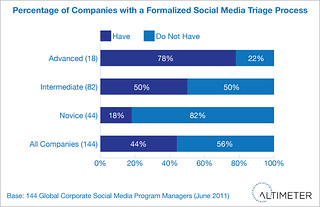 Left: Altimeter Research found that most companies lack a formalized process –and even out of the advanced, only 76% had a process in place, read the full report on Social Readiness.
Left: Altimeter Research found that most companies lack a formalized process –and even out of the advanced, only 76% had a process in place, read the full report on Social Readiness.
The purpose of these breakdown posts is to serve as an industry reference as the space advanced to optimization and performance. The assumption is that a company is forming a Center of Excellence or ruling body, or has recently done so before deploying this key component.
Needs: Companies desire to be efficient –not having a workflow puts company at risk
Like our bodies, cities, and corporations, all complex organisms have a natural process and order that helps to reduce inefficiencies and increases the end goals. So what if you don’t have a workflow? This could put your company at risk from lack of coordination, as multiple individuals could be responding at the same time, your customers may not be properly served in social channels, resulting in lost opportunities and potential customer dis-satisfaction. In the worst case, this poor experience in social could serve to fuel a social media crises, which we’ve documented. Clearly, we want to avoid this scenario, and instead develop a workflow that cascades across the multiple business functions, product groups, and geographies to quickly and effectively serve the market in social channels.
Definition: A Social Media Workflow, Process, or Triage is a sequence of connected steps that enables the entire organization to act efficiently with minimal overlapping tasks and resources in order to serve the market in social channels and beyond.
Business Goals: The 10 Attributes of Successful of Social Media Workflow
First, let’s align the goals of having a successful social media workflow in place, benchmark your goals against the following attributes:
- 1) Alignment with corporate goals and customer goals.
- 2) Buy-in and agreement to the process from all involved business units in the organization.
- 3) Few or no overlapping tasks and resources.
- 4) Clear articulation of who will do what, when, where, and how.
- 5) Organizational alignment through training, testing, and refinement.
- 6) Integration with existing business systems, processes, and software in existing channels.
- 7) A clear, easy-to-reference document with clear labels and requires little explanation.
- 8] Scope includes all possible scenarios are included when to respond –and when not to respond.
- 9) Periodic improvements on the process as the business evolves.
- 10) Measurable business impacts report to all stakeholders on a periodic basis.
Downsides: Identify the Six Roadblocks in Advance
No business initiative goes without risk, and developing a social media workflow could result in the following risks: 1) Scrutiny over the social media program at executive level, 2) Internal territories intensely guarded as a battle over who owns social and the customer experience is fought, 3) Chiefs step in to stop the program until the bigger picture is obtained, 4) A long arduous process is undertaken to get buy in from the entire corporation, which can be saddled if clear executive sponsorship is not setup. 5) Failure to align with existing customer experience channels such as phone, chat, online, and in person. 6) A large risk is the organization not adopting the workflow, falling back into old habits, if a proper rollout is not invested.
Starting with Strategy
Ensure all social media activities (and all else we do) align with the company mission and goals, let’s ensure we’re prepared in having a strategic direction with our peers, executives, and team. Start by:
- Ensure the Goals are Established and Aligned. Obtain agreement from an executive sponsor, ideally one that spans the business groups in which you will engage. Remember, something as pedantic as creating a workflow diagram will excite the organization, resulting in groups to balk, or give their buy-in. Do this by reminding all teams that this is alignment with corporate goals like: customer satisfaction, generating new leads, reducing internal confusion. Clearly label the business goals, and assign interim business KPIs that directly map to these goals.
- Next, Map out Existing Processes and Interview Teams. Expert Jason Falls shared that “Getting the right stakeholders on board from the onset that makes a triage process successful”. Whether you’re in corp comm, customer care, or legal, you’ll need to get buyin from other groups. Start by obtaining existing workflows of how customers are routed, and then interview each team for their needs. Lead with business goals, but instead put on your listening cap to get their important point of view before you assert yours. Then, bring all diagrams back to one document, then ascertain the best process and provide suggested workflows. By allowing business units to vote, modify, and provide input will extend your influence from ‘over-reaching’ to instead getting the ideal ‘buy-in’.
- Avoid the Mine Field by Including Overlooked Stakeholders. Projects can quickly become disparaging if one group inserts and stops the process because their needs were not met. Remember to obtain buy in from corporate functions that are often overlooked including: PR, Corp Comm, Customer Care, IT, Call Center, Regional Field. In particular, loop in Legal, Risk and Compliance in the early days. Jason Falls shared that a leading airline carrier in United States involved legal early on, and had an ongoing role: “A member of senior management and legal are on-call 24/7 to approve and mitigate messages when needed. That’s pretty strong.”
- Rollout Internally through Education, Testing, and Breaking. Emailing a powerpoint triage to all teams that will be involved in the day to day is not sufficient. Ensure a proper kickoff is initiated by conducting a training session, as well as conducting mock process drills in real time. Start with having teams identify message and which routing path it should go into, then simulate how teams will tag, flag, and pass on messages. Ensure proper followup and recording of incident is inputted to correct systems. Be sure to take the process to the limit by simulating crises (see full post) and taking the organization to the level where the workflow is designed to not engage due to critical crises situation.
- Continual Iterations and Coverage, Periodic Measurements. Don’t expect this workflow to perfect in the future, plan on periodic assessments to improve in real time, or at key scheduled dates. Ensure that fire response (corp comm, legal, execs) teams are actively updated on the impacts of the workflow as they may not be involved in daily affairs. Provide all stakeholders periodic reports based on the business KPIs agreed upon, including potential items such as: reduced time to respond to customers, increased customer satisfaction, number of successful incidents resolved, or leads passed to sales for followup.
Notable Examples of Social Media Workflow, Process, Triage
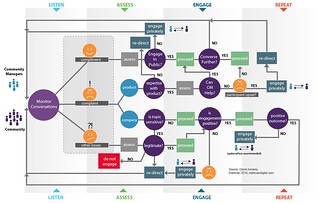
Community Management Scenario Map from David Armano, Edelman
Key decision is based on sentiment, then several if/then statements enable process.
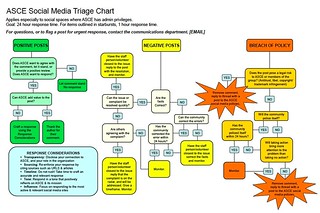
American Society of Civil Engineers’ Social Media Flowchart, via SocialFish
Notice that breach of policy has special actions, also note SLA is set at 1 hour.
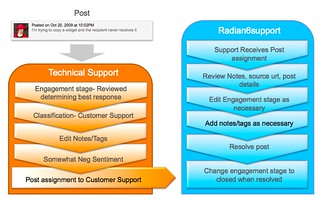
Radian6, owned by Salesforce Provided an Engagement Playbook
Support issues are routed to existing customer support channels, with variation on non-customer use cases.
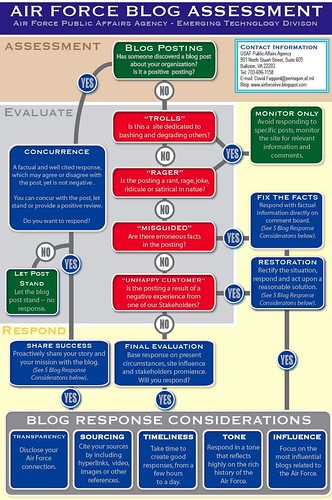
Air Force Blog Triage, older, but one of the first diagrams we saw emerging in 2008
This is a classic which many others are built on, the armed forces have a deep heritage in threat assessments and clear training for enlisted and officers.
Tactics: Anatomy of an Enterprise Social Media Workflow
| Workflow Attribute | Attribute Details | What No One Tells You |
| Flow control | All workflows (even outside of social) help to control where process will flow. | Ensure these workflows include how companies will handle overflow during product launches, events, and off hours and holidays. |
| Crises situations | Often workflow diagrams in social are for the day-to-day situations, for crises, make sure it’s clear on who should be contacted and how | Savvy companies will conduct social media crises fire drills in advance, see this post listing more details. |
| If then, scenarios (falls) | Workflows will have multiple decision points which help to guide the teams on who does what. Include “If then” statements that help individuals to self-guide. | Jason Falls recommends: “When you’re building out triage and work flow it’s like building out the workflow for customer service call centers — you have to anticipate every scenario. What do we say for a product recall? What do we say if an executive is arrested?” |
| Ascertain Situation | Most workflows have either the following triggers to determine the key decision: Sentiment, situation, or who is asking. | Each type of data has an advantage and disadvantage: Sentiment isn’t universally recognized, situations may not take into account tone and nuance, and identities can’t be confirmed. |
| Tag and Flag | To allow for internal coordination, ensure that the process and workflow tools allow content to be tagged, flagged and conjoined to existing customer databases. | Ensure systems work together by requesting social media management systems (SMMS) have on their roadmap the ability to connect with other contact center software, email marketing, or CRM. |
| Response Time | Companies need to internally state how long service level agreement (SLA) will be for different workflow tracks. | Be mindful about how you plan to share this externally, and if at all. We’ve found some companies do not promise this, but instead recommend existing support channels. |
| First Responses | Not all customers want their problems resolved, and may just want to vent. Furthermore, some customers may feel the brand is too ‘big brother’ if they were not following or fans of the brand. | Best practices I learned from Frank Eliason is to first show empathy, then ask if they want help: “I’m sorry to hear of your troubles, is there anything we can do to help?” rather than blurt out a fix that may be unwanted. |
| Engage in public or private channel | Many of the regulated, sensitive account information such as airline and telecommunications will shift ‘off channel’ to other secured channels. | Be up front in your online policies on how you plan to deal with information: be clear on what will be responded to –and will not be in public channels. |
| When not to respond | Make it clear to all parties internally on what type of content will NOT be responded to –and suggest further activity that needs to happen internally. | It’s important to balance proactive response, but also setting expectations on how far we will respond to customers and what appropriate channels are. |
| Integration with Software Tools | In some cases, triage may all happen in social media management system tools (read the report for the full breakdown) but in today’s multi-channel world, they will extend. | Whether it’s contact center software or social media management systems software they must align to the workflows that you build first –don’t allow tools to bend your process, instead focus on your goals first before selecting tools. |
| Followup | Some brands fail to followup with customers after a break has been resolved, or after a customers has recently purchased a product. Have a clear process to followup. | It’s ok to ask customers who have had product woes fixed in social channels to update their posts, so others will see this person has had an issue resolved or not. Be savvy by first asking their satisfaction, then request them to followup. |
| Recording and Measuring | Executives will be requesting clear ROI on your process and triage workflow, you’ll have to map frequency, intensity, and other KPIs. | Map your interactions based on the business goals that were stated up front, whether they are for marketing, support, or coordination, ensure business level KPIs are included. |
Key Industry Resources
- Edelman’s David Armano writes: Social Media Policy & Rules Of Engagement.
- Edelman has published a Slideshare on Social Business for Complex Orgs, see slides 18 and on.
- How to craft an org chart by Social Media Powered
- SmartBlog provides Five essentials for a social media workflow.
- Isra Garcia has an interesting time based workflow that segments the day into specific times to respond.
- While not specific to social, understand the origins of medical triages used in nursing in this slideshare.
- Great industry wide resource on reading Triage diagrams
- Socialfish has some helpful FAQs, and provided the ASCE diagram above.
- Microsoft on building quality workflows –beyond social
- Beth Kanter, provides a lens on workflows for Non Profit.
- Feel free to leave a comment below with more, I plan to cross-link.
The Future State of Workflows:
I interivewed two experts to find out their perspective on the future of workflows.
- The Workflows Fade Into Background. As employees adopt the workflow on a frequency basis, the organizational memory will guide the company. Jason Falls indicated that “Hopefully they’ll (workflows) only look like reminders and guidelines. The worst possible use of a triage, workflow or process is one that is followed step-by-step, looking at the chart. These are guidelines that should be learned and baked into a community manager or marketing staff member’s job. After a while, you should just know what to do. Certainly, you can refer to the charts, graphs and references, but the strong triage processes in any businesses are those run by people who don’t read cue cards.” Jason is right, the work process will soon take a life of it’s own, however the initial documentation and discipline to get the entire organizational on board will be key for corporate buy-in.
- Traditional Contact Center Software will Battle/Integrate with SMMS Vendors. Existing contact center software that already has roots with multi-channel experiences like Genesys, Rightnow, and Liveops already have social interactions and features. On the flip side, Social Media Management System (SMMS) vendors are starting to evolve into paid advertising channels and may include automated chat bots beyond social, read the full report on the SMMS vendor landscape. These two vendors types will have friction as they battle, and expect M&A over coming periods to occur as these vendors coalesce over the same customer types. Watch Oracle, Salesforce, who are assembling their Social Software Suites.
- Soon, Software Will Automate Responses. I agree with the perspective of Jay Baer, who states that: “I see the future of workflow and triage being predictive modeling, with routing based on artificial intelligence and enterprise knowledge mapping. If we know the specific areas of expertise of each employee and can store that in a relational database, and we can also know via presence detection who is online and/or what their historical response times have been, we can use Netbase-style NLP to proactively triage and assign social interactions to the best possible resource in the organization. Automated expertise mining.”. I agree with this direction, and have published my thoughts on the future of social being Performance Social, both on Mashable and Techcrunch.Update, this automation topic triggered a discussion on Branch.
Summary: Don’t Under Estimate the Work Required to Create and Rolllout a Social Workflow.The end result of developing a simple Social Media Workflow doesn’t reflect the herculean effort of organizational navigating, buy-in, and change that may occur in developing the process. Be sure to start with business goals, obtain a clear sponsor, and approach business units by asking –not telling– how they can get involved. Ensure your existing processes, software, and customer experience is augmented, and not replaced by this process. While we’re going to lay the foundation out now in a manual manner, expect that future software systems to correctly anticipate these systems and automate based on data lead programs.
Thanks to time spent with Frank Eliason, David Armano, Jason Falls, and Jay Baer for their expertise, Jessica Groopman for pointing out examples, as well as multiple brand clients who have shared their workflow diagrams with me in client engagements. This breakdown is one small part of how I’m working with companies on their internal social readiness and social programs.
Fantastic playbook Jeremiah. I’ve long-been an advocate of these kinds of processes – just a shame most clients think it’s agency fluff trying to justify their fee.
There is an equally valid loop to close on this with regards to the whatever gets done with the feedback received through these processes.
As a undergrad student I’ve always wondered “why nobody did academic research on internet social network flows”… and I hope somebody would do how Internet posts go viral
I was pleased to see an update from Jeremiah (and Rebecca) on Altimeter’s work to better understand the new marketing paradigm of earned, owned and paid media, and the interplay between each. The conversation is reminiscent of Y&R’s “whole egg” approach to “integrated” marketing — albeit with Ad, PR and Direct as the primary disciplines.
I’ve written about paid/earned/owned recently here: http://theflack.blogspot.com/2012/08/on-entrepreneurs-earned-media.html and more fully here: http://theflack.blogspot.com/2011/06/paid-earned-owned-revisited.html
Like back then at Y&R, each discipline had its respective strengths and weaknesses. Moreover, one often catalyzed the other. (How much editorial attention did Apple’s 1984 ad generate?) In my recent post, I cited an Edelman campaign wherein the company purchased a placement on Buzzfeed for its client Schick, which in turn resulted in earned (editorial) coverage that ultimately was shared and liked in the social spheres.
To me, “shared” media is a desired (and natural) bi-product of an effective earned, owned and/or paid campaign. It’s not a managed discipline in and of itself, though admittedly, marketers need to play in those social sandboxes in order for the groundswell of RTs, likes and shares to happen.
The work Altimeter is doing to better understand how one discipline affects and can cascade to the others is not only important, but vital to the success of today’s marketing communications pros.
Thanks,
Peter Himler
Flatiron Communications LLC
New York
Twitter: peterhimler
What a pronounced assessment! This is
an extensive process that every corporation and even nonprofit organizations
should adopt. Of course it does not need to be as complex but each institution
can mold their model to fit their needs depending how compound their establishment
is. Although some may view this as simplistic and basic, everyday important processes get skipped over that do cause hiccups in the workflow. Each hiccup is a dollar (or more) wasted. I work in a very small department within an educational institution and there
is a workflow in process but from time to time there are blips in the order of workflow because someone forgets the basics. I just might have to pull out the ‘ole charts and do some office trainings. Thank you.